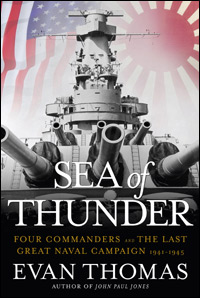 |
Reading about the Pacific War
Friday, April 15, 2011
Last night I finished reading Evan Thomas' Sea of Thunder, a monumental piece of research that explains the Battle of Leyte Gulf, the biggest naval battle in history, with personal stories of some of the more important participants.
 At the beginning of his course "The Pacific War," Harvard's Dennis Skiotis told us that that war was a fight between the US and two enemies: the Japanese and Douglas MacArthur. Sea of Thunder explains much about the war, and, in particular and in detail, it illustrates the lunacy of divided command. It took hours for US commanders around Leyte to send and receive —out of order— urgent messages. At the beginning of his course "The Pacific War," Harvard's Dennis Skiotis told us that that war was a fight between the US and two enemies: the Japanese and Douglas MacArthur. Sea of Thunder explains much about the war, and, in particular and in detail, it illustrates the lunacy of divided command. It took hours for US commanders around Leyte to send and receive —out of order— urgent messages.
The book also illustrates, almost accidentally it seems, the danger of mythologizing commanders for the sake of morale on the home front. Admiral Halsey was buffered against the reasonable second-guessing of his deadly mistakes in communications and in tactics; apparently this protection of his reputation was maintained simply for purposes of morale in the US and in the war theatres. While Halsey's purported greatness was not as fictive as was MacArthur's, he was not nearly as courageous, intelligent, or even skillful as were some of the men whom his blunders sent to foolish deaths.
One cannot with honesty completely blame Halsey for steaming in the wrong direction in the waters east of the Phillipines. After all, it is amazing how regularly battles in the Pacific were won by whichever side had the more aggressive commander, and Halsey was aggressive. However, one cannot excuse his tolerance of a communication system (born of the division of command between Nimitz and MacArthur) that was so useless (or much worse than useless) when it was most needed. Evidence that Halsey's failures are unforgivable lies in the fact that he apparently never forgave himself.
The book, published about five years ago, has some minor editorial flaws that one hopes have been or will be tidied. Also, after finishing it, I am not quite sure to which commanders the subtitle "Four Commanders and the Last Great Naval Campaign" refers. (This problem is probably mine.) That said, I wholeheartedly recommend this book to any student of the Pacific War or anyone who desires an understanding of the phrase "the fog of war."
|